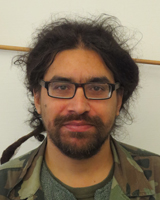Personalia
Harald Hammarström, born in Västerås, Sweden, 1977. Ph.D. from Chalmers University, Gothenburg, Sweden. Researcher at Max Planck Institute for Psycholinguistics, Nijmegen.
Theme Group Coordinator (1 September – 30 November 2015)
Capturing Phylogenetic Algorithms for Linguistics
Research Question
How to use a computer to calculate the history of languages starting from linguistic data.
Project Description
For centuries, linguists have reconstructed trees from contemporary data (words, sound changes, grammatical features) on languages. The trees reflect the historical dispersion of the languages and, in want of written testimonies, are our only reliable source on the prehistoric movement of the populations involved. The most well-known such tree is the Indo-European family tree, underlying hundreds of geographically disparate modern languages, such as Afrikaans, English and Hindi. Other well-known families are Austronesian (over 1000 languages in the Indo-Pacific archipelago), Niger-Congo (over 1000 languages in Sub-Saharan Africa) and Sino-Tibetan (hundreds of languages in China and the Himalayas). Not only which languages are related, but how close they are related is the following question. For example, observing that English and Dutch resemble each other more than either to Hindi, one may argue that they two of them should form subgroup. Thanks to information on what are likely kinds and amounts of changes, it is possible to make principled inferences on what are more likely scenarios. With more data, more languages and the possibility that one or more characteristics may be borrowed across branches, these problems become enormously complicated. Language tree-reconstruction has traditionally been done manually by humans. But key parts of the tree-reconstruction, i.e., looking up words in a dictionary, weighting of evidence for millions of alternative tree scenarios, etc are better suited for a computer. Only now, in the digital age, are both computational power and large linguistic datasets available.
Selected Publications
1) Hammarström, Harald. 2013. Pronouns and the (Preliminary) Classification of Papuan languages. In Harald Hammarström & Wilco van den Heuvel (eds.), History, contact and classi?cation of Papuan languages (LLM Special Issue 2012), 428-539. Port Moresby: Linguistic Society of Papua New Guinea.
2) Hammarström, Harald. 2010a. Rarities in Numeral Systems. In Jan Wohlgemuth & Michael Cysouw (eds.), Rethinking Universals: How rarities affect linguistic theory (Empirical Approaches to Language Typology 45), 11-60. Berlin: Mouton de Gruyter.
3) Harald Hammarström 2008 Counting Languages in Dialect Continua Using the Criterion of Mutual Intelligibility. Journal of Quantitative Linguistics 15(1), pp. 36-45.
